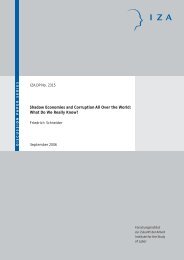Health Outcomes and Socio-Economic Status among ... - Index of - IZA
Health Outcomes and Socio-Economic Status among ... - Index of - IZA
Health Outcomes and Socio-Economic Status among ... - Index of - IZA
Create successful ePaper yourself
Turn your PDF publications into a flip-book with our unique Google optimized e-Paper software.
1. Introduction<br />
We are concerned in this paper with measuring health outcomes <strong>among</strong> the elderly in<br />
Zhejiang <strong>and</strong> Gansu provinces, China, <strong>and</strong> examining the relationships between different<br />
dimensions <strong>of</strong> health status <strong>and</strong> measures <strong>of</strong> socio-economic status (SES). China has undergone<br />
a health revolution over the past 50 years, with life expectancy having risen from 46 in the 1950s<br />
to just over 71 in 2000 (Wagstaff et al., 2009; World <strong>Health</strong> Organization, 2009). Driving this<br />
change, under 5 mortality fell dramatically from 225 per 1,000 live births in 1960 to 64 in 1980<br />
to 22 in 2007 (Wagstaff et al., 2009; UNICEF, 2009). Most <strong>of</strong> this decline was due to an<br />
increasing control over infectious disease <strong>and</strong> under-nutrition. As a result, infectious diseases<br />
have been progressively replaced by chronic diseases as the major source <strong>of</strong> ill-health <strong>and</strong><br />
mortality (Hossein, 1997; Lopez et al., 2006).<br />
As China has been passing through its health transition, it has also been undergoing a<br />
nutrition transition, which has both good <strong>and</strong> bad sides (Popkin et al., 1993, 1995a; Popkin,<br />
1999, 2002). Among the principle dimensions <strong>of</strong> this transition has been a dramatic rise in body<br />
mass index <strong>among</strong> adults <strong>and</strong> a large change in diet towards more fatty foods (Popkin et al.,<br />
1995b). For instance Luo (2003), using the China <strong>Health</strong> <strong>and</strong> Nutrition Survey (CHNS),<br />
documents an increase in overweight for adults over 20 years from 1989 to 1997; for women<br />
from 11% to 21% <strong>and</strong> from 6% to 17% for men. 1 At the same time, Luo shows that the fraction<br />
<strong>of</strong> adults elderly who are undernourished (a BMI under 18.5) has fallen, particularly so for those<br />
over 60 years, from 19% to 13% for women <strong>and</strong> 20% to 12% for men, from 1991 to 1997.<br />
Related to the health <strong>and</strong> nutrition transitions has been China’s demographic transition.<br />
China’s elderly will increase from under 10% <strong>of</strong> the total population in 2000 to 30% in 2050<br />
1 Overweight is defined using World <strong>Health</strong> Organization st<strong>and</strong>ards <strong>of</strong> having a BMI 25 or above.<br />
3
















